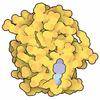[English] 日本語
 Yorodumi
Yorodumi- PDB-3erd: HUMAN ESTROGEN RECEPTOR ALPHA LIGAND-BINDING DOMAIN IN COMPLEX WI... -
+ Open data
Open data
- Basic information
Basic information
| Entry | Database: PDB / ID: 3erd | |||||||||
|---|---|---|---|---|---|---|---|---|---|---|
| Title | HUMAN ESTROGEN RECEPTOR ALPHA LIGAND-BINDING DOMAIN IN COMPLEX WITH DIETHYLSTILBESTROL AND A GLUCOCORTICOID RECEPTOR INTERACTING PROTEIN 1 NR BOX II PEPTIDE | |||||||||
 Components Components |
| |||||||||
 Keywords Keywords | NUCLEAR RECEPTOR / TRANSCRIPTION FACTOR / ESTROGEN / AGONIST / COACTIVATOR | |||||||||
| Function / homology |  Function and homology information Function and homology informationregulation of epithelial cell apoptotic process / RNA polymerase II intronic transcription regulatory region sequence-specific DNA binding / antral ovarian follicle growth / regulation of branching involved in prostate gland morphogenesis / RUNX1 regulates transcription of genes involved in WNT signaling / RUNX1 regulates estrogen receptor mediated transcription / regulation of toll-like receptor signaling pathway / nuclear estrogen receptor activity / epithelial cell development / steroid hormone receptor signaling pathway ...regulation of epithelial cell apoptotic process / RNA polymerase II intronic transcription regulatory region sequence-specific DNA binding / antral ovarian follicle growth / regulation of branching involved in prostate gland morphogenesis / RUNX1 regulates transcription of genes involved in WNT signaling / RUNX1 regulates estrogen receptor mediated transcription / regulation of toll-like receptor signaling pathway / nuclear estrogen receptor activity / epithelial cell development / steroid hormone receptor signaling pathway / epithelial cell proliferation involved in mammary gland duct elongation / prostate epithelial cord elongation / prostate epithelial cord arborization involved in prostate glandular acinus morphogenesis / locomotor rhythm / mammary gland branching involved in pregnancy / uterus development / negative regulation of smooth muscle cell apoptotic process / aryl hydrocarbon receptor binding / vagina development / TFIIB-class transcription factor binding / cellular response to Thyroglobulin triiodothyronine / regulation of lipid metabolic process / androgen metabolic process / regulation of glucose metabolic process / Synthesis of bile acids and bile salts / mammary gland alveolus development / cellular response to estrogen stimulus / estrogen response element binding / Synthesis of bile acids and bile salts via 27-hydroxycholesterol / Endogenous sterols / Synthesis of bile acids and bile salts via 7alpha-hydroxycholesterol / Mitochondrial unfolded protein response (UPRmt) / nuclear receptor-mediated steroid hormone signaling pathway / positive regulation of DNA-binding transcription factor activity / negative regulation of DNA-binding transcription factor activity / Nuclear signaling by ERBB4 / cellular response to hormone stimulus / RNA polymerase II preinitiation complex assembly / Recycling of bile acids and salts / transcription regulator inhibitor activity / positive regulation of nitric-oxide synthase activity / estrogen receptor signaling pathway / protein localization to chromatin / steroid binding / : / 14-3-3 protein binding / positive regulation of adipose tissue development / Regulation of lipid metabolism by PPARalpha / TFAP2 (AP-2) family regulates transcription of growth factors and their receptors / negative regulation of canonical NF-kappaB signal transduction / peroxisome proliferator activated receptor signaling pathway / regulation of cellular response to insulin stimulus / BMAL1:CLOCK,NPAS2 activates circadian expression / SUMOylation of transcription cofactors / ESR-mediated signaling / Activation of gene expression by SREBF (SREBP) / response to progesterone / TBP-class protein binding / negative regulation of miRNA transcription / nitric-oxide synthase regulator activity / nuclear estrogen receptor binding / nuclear receptor binding / transcription corepressor binding / transcription coregulator binding / negative regulation of smoothened signaling pathway / stem cell differentiation / SUMOylation of intracellular receptors / circadian regulation of gene expression / cellular response to estradiol stimulus / mRNA transcription by RNA polymerase II / Heme signaling / euchromatin / Transcriptional activation of mitochondrial biogenesis / PPARA activates gene expression / Cytoprotection by HMOX1 / Activated PKN1 stimulates transcription of AR (androgen receptor) regulated genes KLK2 and KLK3 / beta-catenin binding / Nuclear Receptor transcription pathway / Transcriptional regulation of white adipocyte differentiation / response to estrogen / transcription coactivator binding / RNA polymerase II transcription regulator complex / male gonad development / nuclear receptor activity / positive regulation of fibroblast proliferation / Constitutive Signaling by Aberrant PI3K in Cancer / Regulation of RUNX2 expression and activity / positive regulation of nitric oxide biosynthetic process / sequence-specific double-stranded DNA binding / Ovarian tumor domain proteases / : / response to estradiol / PIP3 activates AKT signaling / HATs acetylate histones / positive regulation of cytosolic calcium ion concentration / ATPase binding / MLL4 and MLL3 complexes regulate expression of PPARG target genes in adipogenesis and hepatic steatosis / PI5P, PP2A and IER3 Regulate PI3K/AKT Signaling / regulation of inflammatory response / fibroblast proliferation Similarity search - Function | |||||||||
| Biological species |  Homo sapiens (human) Homo sapiens (human) | |||||||||
| Method |  X-RAY DIFFRACTION / X-RAY DIFFRACTION /  SYNCHROTRON / SYNCHROTRON /  MOLECULAR REPLACEMENT / Resolution: 2.03 Å MOLECULAR REPLACEMENT / Resolution: 2.03 Å | |||||||||
 Authors Authors | Shiau, A.K. / Barstad, D. / Loria, P.M. / Cheng, L. / Kushner, P.J. / Agard, D.A. / Greene, G.L. | |||||||||
 Citation Citation |  Journal: Cell(Cambridge,Mass.) / Year: 1998 Journal: Cell(Cambridge,Mass.) / Year: 1998Title: The structural basis of estrogen receptor/coactivator recognition and the antagonism of this interaction by tamoxifen. Authors: Shiau, A.K. / Barstad, D. / Loria, P.M. / Cheng, L. / Kushner, P.J. / Agard, D.A. / Greene, G.L. | |||||||||
| History |
|
- Structure visualization
Structure visualization
| Structure viewer | Molecule:  Molmil Molmil Jmol/JSmol Jmol/JSmol |
|---|
- Downloads & links
Downloads & links
- Download
Download
| PDBx/mmCIF format |  3erd.cif.gz 3erd.cif.gz | 116.8 KB | Display |  PDBx/mmCIF format PDBx/mmCIF format |
|---|---|---|---|---|
| PDB format |  pdb3erd.ent.gz pdb3erd.ent.gz | 88.7 KB | Display |  PDB format PDB format |
| PDBx/mmJSON format |  3erd.json.gz 3erd.json.gz | Tree view |  PDBx/mmJSON format PDBx/mmJSON format | |
| Others |  Other downloads Other downloads |
-Validation report
| Summary document |  3erd_validation.pdf.gz 3erd_validation.pdf.gz | 465.8 KB | Display |  wwPDB validaton report wwPDB validaton report |
|---|---|---|---|---|
| Full document |  3erd_full_validation.pdf.gz 3erd_full_validation.pdf.gz | 472.1 KB | Display | |
| Data in XML |  3erd_validation.xml.gz 3erd_validation.xml.gz | 11.7 KB | Display | |
| Data in CIF |  3erd_validation.cif.gz 3erd_validation.cif.gz | 18 KB | Display | |
| Arichive directory |  https://data.pdbj.org/pub/pdb/validation_reports/er/3erd https://data.pdbj.org/pub/pdb/validation_reports/er/3erd ftp://data.pdbj.org/pub/pdb/validation_reports/er/3erd ftp://data.pdbj.org/pub/pdb/validation_reports/er/3erd | HTTPS FTP |
-Related structure data
| Related structure data |  3ertC 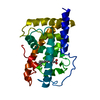 2lbdS S: Starting model for refinement C: citing same article ( |
|---|---|
| Similar structure data |
- Links
Links
- Assembly
Assembly
| Deposited unit | 
| ||||||||
|---|---|---|---|---|---|---|---|---|---|
| 1 |
| ||||||||
| Unit cell |
| ||||||||
| Noncrystallographic symmetry (NCS) | NCS oper: (Code: given Matrix: (0.573343, 0.556926, 0.600926), Vector: |
- Components
Components
-Protein / Protein/peptide , 2 types, 4 molecules ABCD
| #1: Protein | Mass: 29850.217 Da / Num. of mol.: 2 / Fragment: LIGAND-BINDING DOMAIN Source method: isolated from a genetically manipulated source Source: (gene. exp.)  Homo sapiens (human) / Gene: ESTROGEN RECEPTOR ALPHA / Plasmid: PET23D / Cellular location (production host): CYTOPLASM / Production host: Homo sapiens (human) / Gene: ESTROGEN RECEPTOR ALPHA / Plasmid: PET23D / Cellular location (production host): CYTOPLASM / Production host:  #2: Protein/peptide | Mass: 1579.866 Da / Num. of mol.: 2 / Fragment: NUCLEAR RECEPTOR BOX II / Source method: isolated from a natural source / Source: (natural)  Homo sapiens (human) / References: GenBank: 1853980, UniProt: Q15596*PLUS Homo sapiens (human) / References: GenBank: 1853980, UniProt: Q15596*PLUS |
|---|
-Non-polymers , 4 types, 152 molecules 






| #3: Chemical | ChemComp-CL / | ||||
|---|---|---|---|---|---|
| #4: Chemical | | #5: Chemical | #6: Water | ChemComp-HOH / | |
-Experimental details
-Experiment
| Experiment | Method:  X-RAY DIFFRACTION / Number of used crystals: 1 X-RAY DIFFRACTION / Number of used crystals: 1 |
|---|
- Sample preparation
Sample preparation
| Crystal | Density Matthews: 2.1 Å3/Da / Density % sol: 42 % | |||||||||||||||||||||||||
|---|---|---|---|---|---|---|---|---|---|---|---|---|---|---|---|---|---|---|---|---|---|---|---|---|---|---|
| Crystal grow | pH: 8.5 Details: WELL: 25-27%(W/V) PEG 4000, 0.180 M SODIUM ACETATE, 0.90 M TRIS PH 8.75-9.0 PROTEIN: 4.3 G/L TEMPERATURE: 19-21 DEGREES C, pH 8.5 | |||||||||||||||||||||||||
| Crystal grow | *PLUS Temperature: 19-21 ℃ / Method: vapor diffusion, hanging drop | |||||||||||||||||||||||||
| Components of the solutions | *PLUS
|
-Data collection
| Diffraction | Mean temperature: 100 K |
|---|---|
| Diffraction source | Source:  SYNCHROTRON / Site: SYNCHROTRON / Site:  SSRL SSRL  / Beamline: BL7-1 / Wavelength: 1.08 / Beamline: BL7-1 / Wavelength: 1.08 |
| Detector | Type: MARRESEARCH / Detector: IMAGE PLATE / Date: May 1, 1998 / Details: PT COATED, FUSED SILICA |
| Radiation | Monochromator: SI(111) / Protocol: SINGLE WAVELENGTH / Monochromatic (M) / Laue (L): M / Scattering type: x-ray |
| Radiation wavelength | Wavelength: 1.08 Å / Relative weight: 1 |
| Reflection | Resolution: 2.03→27 Å / Num. obs: 30265 / % possible obs: 98.4 % / Observed criterion σ(I): -3 / Redundancy: 3.4 % / Biso Wilson estimate: 19.8 Å2 / Rsym value: 0.078 / Net I/σ(I): 9.8 |
| Reflection shell | Resolution: 2.03→2.07 Å / Mean I/σ(I) obs: 1.8 / Rsym value: 0.519 / % possible all: 98 |
| Reflection | *PLUS Num. measured all: 104189 / Rmerge(I) obs: 0.078 |
| Reflection shell | *PLUS % possible obs: 98 % / Rmerge(I) obs: 0.519 |
- Processing
Processing
| Software |
| ||||||||||||||||||||||||||||||||||||||||||||||||||||||||||||
|---|---|---|---|---|---|---|---|---|---|---|---|---|---|---|---|---|---|---|---|---|---|---|---|---|---|---|---|---|---|---|---|---|---|---|---|---|---|---|---|---|---|---|---|---|---|---|---|---|---|---|---|---|---|---|---|---|---|---|---|---|---|
| Refinement | Method to determine structure:  MOLECULAR REPLACEMENT MOLECULAR REPLACEMENTStarting model: 2LBD Resolution: 2.03→27 Å / Data cutoff high absF: 1000000 / Data cutoff low absF: 0.001 / Cross valid method: THROUGHOUT / σ(F): 0
| ||||||||||||||||||||||||||||||||||||||||||||||||||||||||||||
| Displacement parameters | Biso mean: 33.9 Å2
| ||||||||||||||||||||||||||||||||||||||||||||||||||||||||||||
| Refinement step | Cycle: LAST / Resolution: 2.03→27 Å
| ||||||||||||||||||||||||||||||||||||||||||||||||||||||||||||
| Refine LS restraints |
| ||||||||||||||||||||||||||||||||||||||||||||||||||||||||||||
| LS refinement shell | Resolution: 2.03→2.12 Å / Total num. of bins used: 8
| ||||||||||||||||||||||||||||||||||||||||||||||||||||||||||||
| Xplor file |
| ||||||||||||||||||||||||||||||||||||||||||||||||||||||||||||
| Software | *PLUS Name:  X-PLOR / Version: 3.854 / Classification: refinement X-PLOR / Version: 3.854 / Classification: refinement | ||||||||||||||||||||||||||||||||||||||||||||||||||||||||||||
| Refinement | *PLUS Rfactor obs: 0.196 | ||||||||||||||||||||||||||||||||||||||||||||||||||||||||||||
| Solvent computation | *PLUS | ||||||||||||||||||||||||||||||||||||||||||||||||||||||||||||
| Displacement parameters | *PLUS | ||||||||||||||||||||||||||||||||||||||||||||||||||||||||||||
| Refine LS restraints | *PLUS
| ||||||||||||||||||||||||||||||||||||||||||||||||||||||||||||
| LS refinement shell | *PLUS Rfactor obs: 0.264 |
 Movie
Movie Controller
Controller



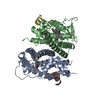

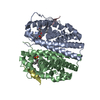
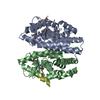
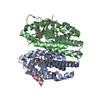



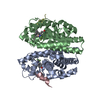
 PDBj
PDBj



